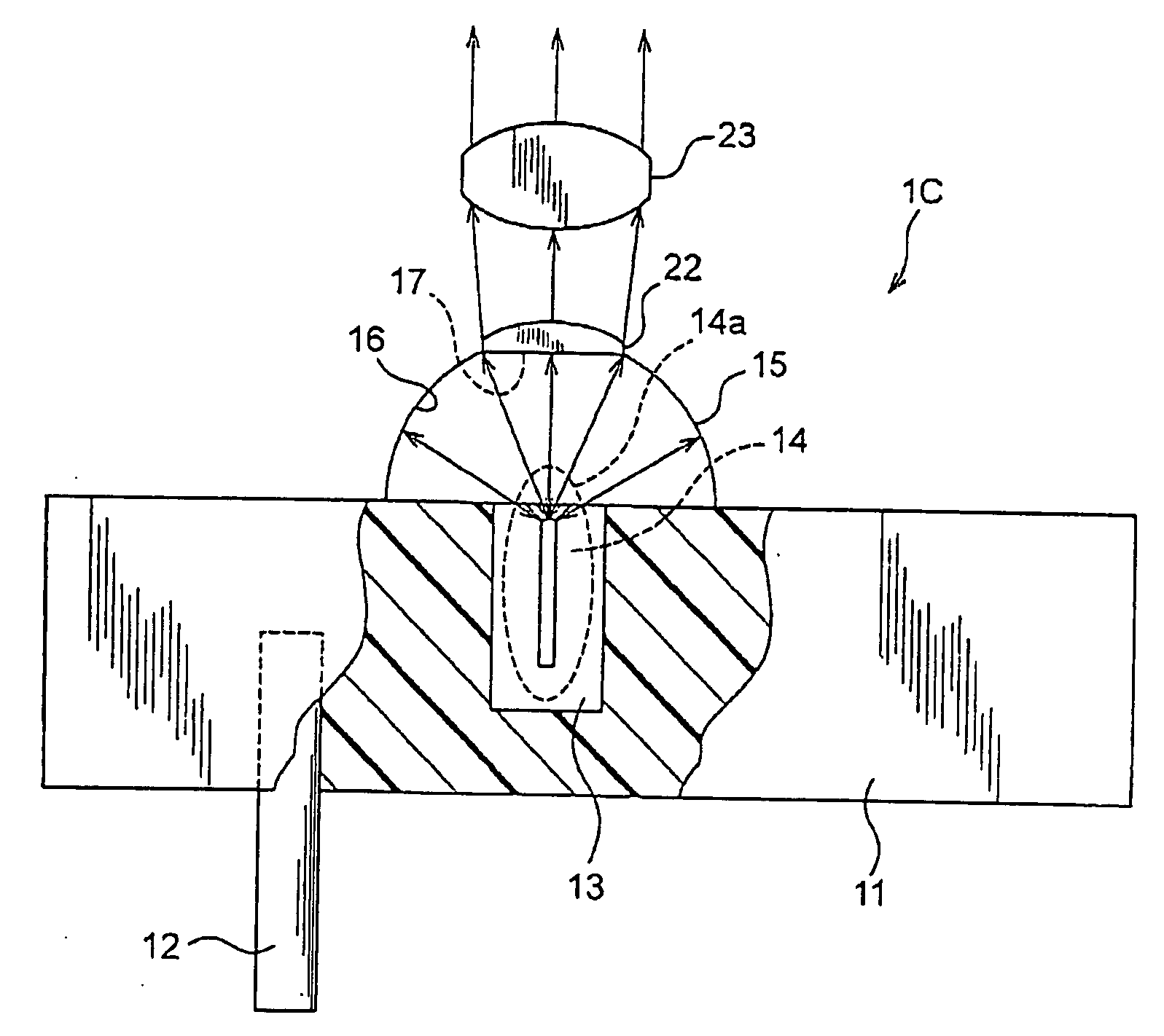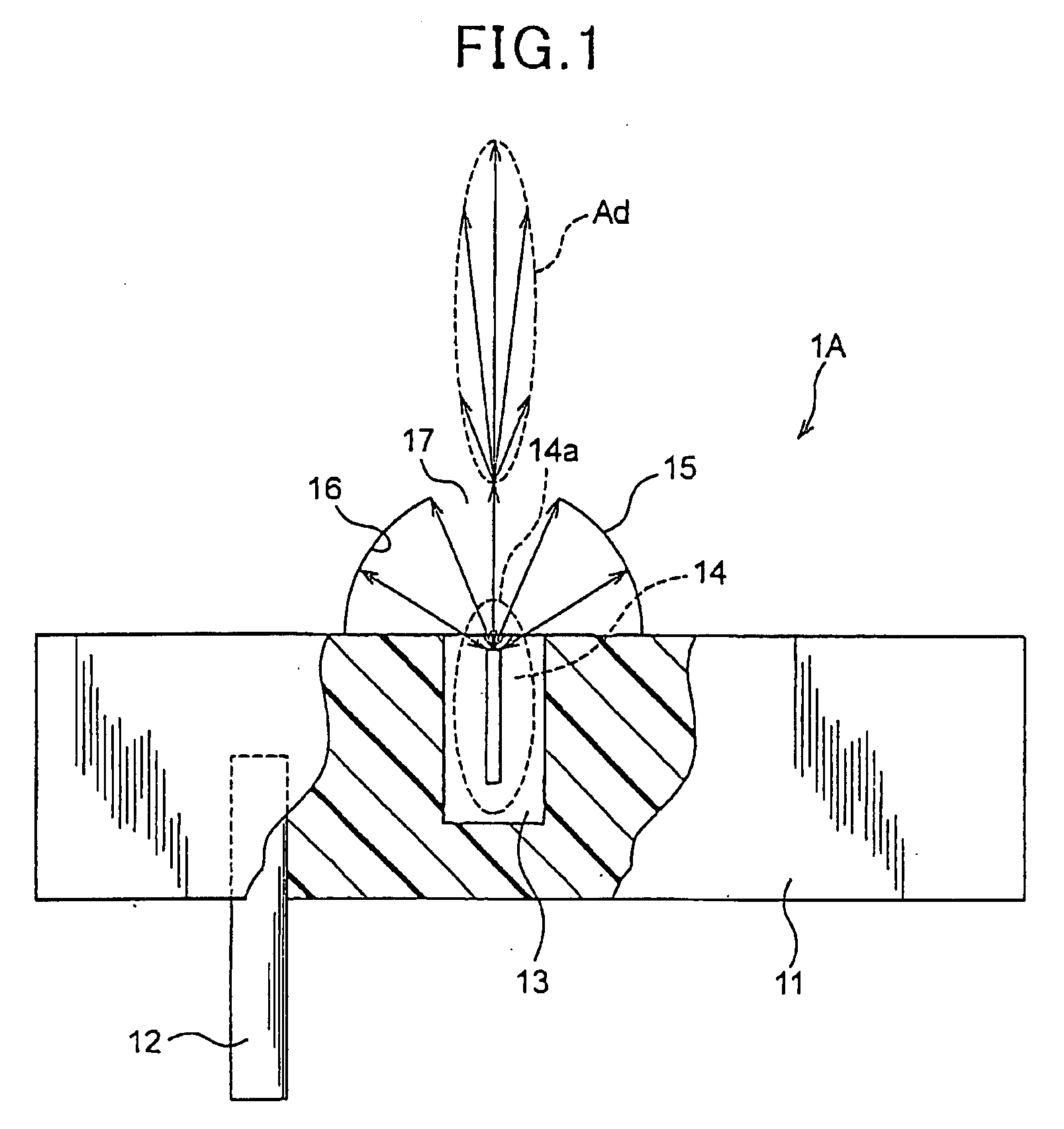Light source device and image displaying apparatus using the same
- Summary
- Abstract
- Description
- Claims
- Application Information
AI Technical Summary
Benefits of technology
Problems solved by technology
Method used
Image
Examples
first embodiment
[0030] Referring to FIG. 1, a first embodiment of the light source device according to the present invention will now be described.
[0031] As shown in FIG. 1, a light source device 1A of the present embodiment is provided with a waveguide 11, a probe 12, an electrodeless lamp 14, and a spherical reflecting mirror 15. Of these, the waveguide 11 is a cylindrical member made of a dielectric material with an outer surface coated with a metal material. The waveguide 11 has a central axis along an axial direction and both circular end surfaces in the axial direction. At a part of one of both axial end surfaces, which part is located at the center or near the center thereof, an aperture cavity 13 is formed to open outside.
[0032] The electrodeless lamp 14 is a lamp emitting light in response to applying microwaves thereto and is formed to have a thin and long shape having a longitudinal direction. This electrodeless lamp 14 is loaded in the aperture cavity 13 such that one end of this elec...
second embodiment
[0038] Referring to FIG. 2, a second embodiment of the present invention will now be described. In the present embodiment and subsequent embodiments, for the sake of removing redundancy of the description, components identical or similar to those described in the previous embodiments will be given the same reference numerals and the explanations therefore will be omitted or simplified.
[0039] In the present embodiment, the light source device is reduced Into practice in another form.
[0040]FIG. 2 shows the structure of a light source device 1B according to the present embodiment. As shown therein, the light source device 1B is additionally provided with a convex lens 21 mounted on the spherical reflecting mirror 15 to cover the aperture 17 thereof. The remaining components of this device 1B are identical to those in FIG. 1 explaining the first embodiment.
[0041] Accordingly, the flux of light radiated through the aperture 17 of the spherical reflecting mirror 15 is collimated into a...
third embodiment
[0043] Referring to FIG. 3, a second embodiment of the present invention will now be described. In the present embodiment, the light source device is reduced into practice in another form.
[0044]FIG. 3 shows the structure of a light source device 1C according to the present embodiment. As shown therein, the light source device 1C is additionally provided with a lens system consisting of convex lenses 22 and 23. Of these, the convex lens 22 is mounted on the spherical reflecting mirror 15 to cover the aperture 17 thereof, while the convex lens 23 is fixedly located apart from the convex lens 22 by a predetermined distance in front of the convex lens 22. The remaining components of this device 1C are identical to those in FIG. 1 explaining the first embodiment.
[0045] Hence the flux of light radiated through the aperture 17 of the spherical reflecting mirror 15 is narrowed in its radiation angle by the first convex lens 22, and then collimated by the second convex lens 23. Accordingly...
PUM
 Login to View More
Login to View More Abstract
Description
Claims
Application Information
 Login to View More
Login to View More - R&D
- Intellectual Property
- Life Sciences
- Materials
- Tech Scout
- Unparalleled Data Quality
- Higher Quality Content
- 60% Fewer Hallucinations
Browse by: Latest US Patents, China's latest patents, Technical Efficacy Thesaurus, Application Domain, Technology Topic, Popular Technical Reports.
© 2025 PatSnap. All rights reserved.Legal|Privacy policy|Modern Slavery Act Transparency Statement|Sitemap|About US| Contact US: help@patsnap.com



